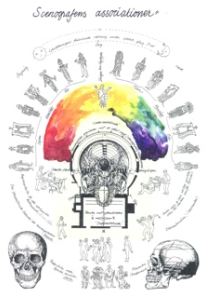Sunniva Thelestam
Presentation for the joint meeting of OISTAT Performance Design and OISTAT Research 2013, Shanghai, China
Eugene O’Neill’s The Emperor Jones (1920) is arguably one of the best stageplays ever written. The story concerns a dictator on a Caribbean island who is overthrown by a counter-revolution and flees through the jungle in search of his getaway ship.
While lost in the jungle Jones has visions of his former criminal life, which he scares away by firing shots with his 6-bullet revolver.
O’Neill has lengthy stage directions about how to visualize Jones’s dreams.
The problem today is that these stage directions are theatrically outdated and, if realized, would turn the performance to childish puppetry.
The genius of The Emperor Jones is that O’Neill – at the height of expressionism – endeavours to visualize what goes on in the emperor’s head and at the same time the clash of cultures within the African American nation. For the author does not only trace the personal history of Brutus Jones, but goes on to describing Jones’s passage from Africa to America on the slave ships and his humbleness in front of deities from the Voodoo religion in Western Africa – scenes which Jones could not possibly have experienced in real life, but which are inherent, as it were, in the genetic memory of the African American.
I was scenographer and costume designer for a production of The Emperor Jones at the Stockholm Opera where the play had been set to music by Sweden’s foremost contemporary composer Sven-David Sandström.
My problem was how to visualise the play’s main components: 1. The clash of cultures, 2. The sense that all happens inside the head of Jones.
My presentation will show how we designed the auditorium, the spatial relationship between spectators, choir, orchestra and the dancers –or rather mime artists – who visualized Jones’s phantasies. Also how the costumes of the choir, based on my studies of the Voodoo religion, became part of the scenography.
The photos are provided by Sunniva Thelestam.
The poster. Some physical characters. The Housemaid, The Emperor and mr. Smithers.


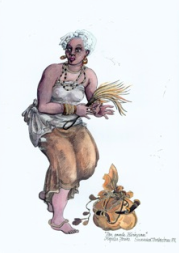

These figures represent the second level beings. They are in between humans and Nature.
The mimers, you might call them "elementary beings" embody the little formless fears; figures of the forest.
Their body stockings, leotards, are painted with fluorescent colour so that only the patterns or structures of Nature will be seen in black light
when they form stones, water, trees a.s.o.
The Witch doctor is also somewhere between human and nature.
As you might notice these characters wear half masks.
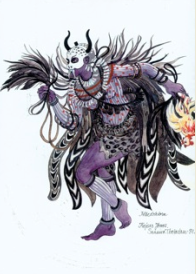


The choir are from the beginning behind and around the audience, standing still like puppets, before they burst out singing.
They represent the African cultural heritage. They may also be ancestors. According to the Voodoo belief they are not allowed to show
their true faces on any account. You may only see the "fetish" above their heads, in which the spirit is incarnated.
All materials and patterns are hand-painted and crafted. There were some extremely difficult technical problems to be solved
since the opera singers inside the costumes had to see in the dark, catch the notes from each other without an echo inside the mask
and, of course, not to suffocate...

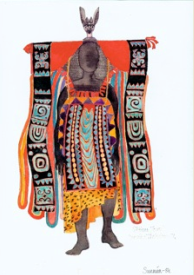

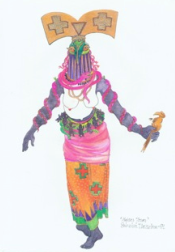
Here are some more tenors and basso singers.


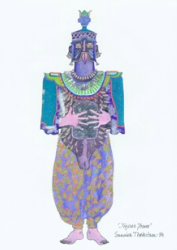



And at last a sort of overview, you might call it mindmapping or the scenographer's associations.
The photo from the performance shows the mimers in action.
The Voodoo ritual liturgy is translated into modern traffic symbols drawn on the floor with luminate colour.
The choir members behind the projection canvas are showing memories arising in the Emperor's mind.
Extensions of the Little Formless Fears dancing on the stage floor.
